Churchill's Birthplace: Magnificent Blenheim Palace
by Martha Doe
Blenheim Palace was born from the blood and sweat of the
battleground. Built to honour John Churchill, the 1st Duke of
Marlborough, after he led an allied victory against the French in
1704, its construction was beset by periods of betrayal, intrigue
and exile. Two hundred years later, the stately home served as
the birthplace for Britain's greatest wartime leader, Winston
Churchill.
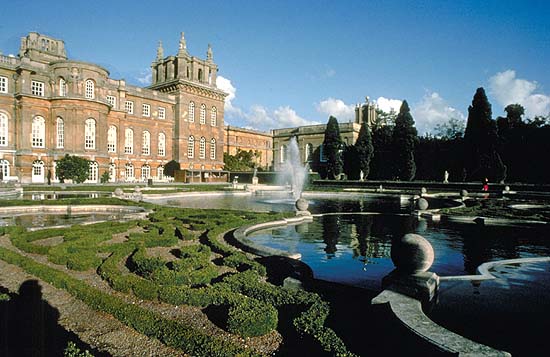
Rather than a being a home, Blenheim is best described as a
lavish monument to military glory. That's not to say that the
palace hasn't had its fair share of residents. For over 300
years, Blenheim has housed and romanced an array of colourful
people.
Designed by the playwright Sir John Vanbrugh, Blenheim palace was
a gift of gratitude from Queen Anne. The magnificent house was
built on Woodstock Manor, a former royal hunting lodge and at one
time a prison for Princess Elizabeth (later Queen Elizabeth I)
for her alleged role in the Wyatt plot. In 1709 the manor was
destroyed on the orders of the 1st Duchess of Marlborough, and a
large part of the rubble was used to fill the foundation for
Vanbrugh's Grand Bridge.
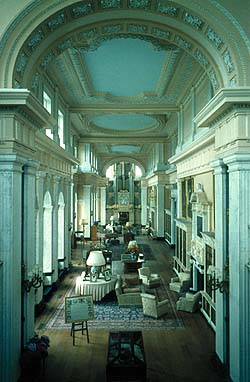 The Marlboroughs fell from the Queen's favour in 1711 and were
banished from the country for several years. Upon returning they
were met with the news that Blenheim would be finished at their
own expense. For the two decades it took to complete, Sarah, the
first duchess, held bitter disputes with Vanbrugh over money and
eventually barred him from even entering the palace.
The Marlboroughs fell from the Queen's favour in 1711 and were
banished from the country for several years. Upon returning they
were met with the news that Blenheim would be finished at their
own expense. For the two decades it took to complete, Sarah, the
first duchess, held bitter disputes with Vanbrugh over money and
eventually barred him from even entering the palace.
Immediately upon arriving at Blenheim, the visitor must pass
through an archway depicting a cockerel (the emblem of France)
being forced down by a British lion. Altogether, there are around
15 references to British victories against the French on the
palace exterior. Inside the theme continues in the Great Hall.
Its ceiling, painted by Sir James Thornhill in 1716, shows a
victorious Duke of Marlborough. In the green writing room a
delicate tapestry hangs from the wall, depicting the battle of
Blenheim and Marlborough accepting French surrender.
Between the Saloon -- a state dining room used by the family once
a year on Christmas Day -- and the Long Library there are three
interconnecting areas known as The First, Second and Third State
Rooms. All three apartments are adorned with tapestries of
Marlborough's later campaigns, commissioned by the Duke
himself.
The Long Library was originally designed as a picture gallery but
is now home to a collection of 10,000 books, a collection largely
compiled by the 9th Duke. Full-length portraits of Queen Anne,
King William III and John Churchill, the 1st Duke of Marlborough,
hang from the walls of this 55-metre-long room. At the north end
sits the spectacular Willis organ, accompanied by marble
sculptures of Queen Anne and the 1st Duke.
During the 1800's, the second Duke of Marlborough auctioned off
several books -- along with Raphael paintings and priceless
furniture -- in order to clear his numerous debts. The 7th Duke
also faced large financial problems, eased somewhat by an Act of
Parliament (the Blenheim Settled Estates Act of 1880), which
allowed for priceless Marlborough heirlooms to be sold.
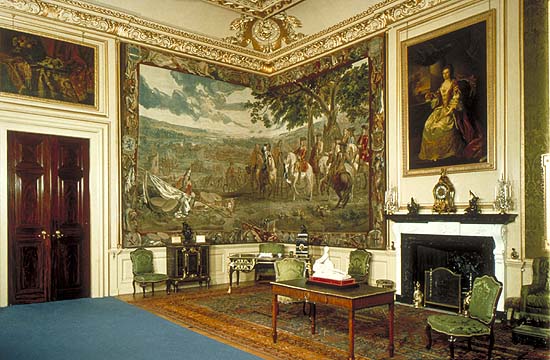
Fortunately Blenheim still houses several fine paintings,
sculptures, porcelain and silver collections and furniture. Just
outside the Green Drawing Room, the China Cabinet holds a
spectacular collection of Meissen porcelain, acquired by the 3rd
Duke in exchange for a pack of staghounds.
During the 19th century two of the family's men married rich
American heiresses, events that probably saved Blenheim Palace
from ruin. One of those women was Jennie Jerome, daughter of the
rich New Yorker Leonard Jerome. She became the wife of Lord
Randolph Churchill and Winston Churchill's mother.
Jennie described her arrival to Blenheim in a letter to her
sister: "As we passed through the entrance archway and the lovely
scenery burst upon me, Randolph said with pardonable pride, 'This
is the finest view in EnglandΙ' Looking at the lake, the bridge,
the miles of magnificent park studded with old oaks and the huge
stately palace, I confess I felt awed. But my American pride
forbade the admission."
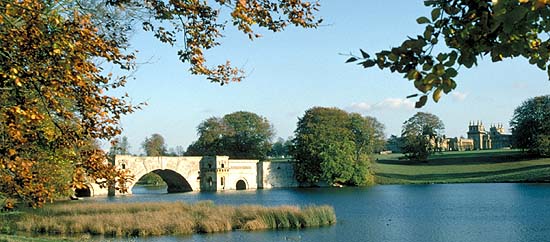
Desperately in need of a large fortune to cover the palace's
colossal expenses, in 1896 the 9th Duke of Marlborough also
married a rich American --18-year-old Consuelo Vanderbilt. In the
Red Drawing Room, a painting by John Singer Sargent depicts the
Duke with his wife Consuelo and their son, the present Duke of
Marlborough. Consuelo came with a dowry of $2.5 million in
railroad stock, which enabled the fading palace to be restored
to its former glory. She regularly undertook charitable works
around town and became known as "the Angel of Woodstock."
The arranged marriage was not a happy one, however, and the
couple separated in 1906, finally divorcing in 1921. Her son and
grandson, the 10th and 11th dukes, have ensured that her
portraits remain -- her elegant image can be seen hanging in
various rooms throughout the palace. The 9th Duke went on marry a
second American, a friend of Consuelo's named Gladys Deacon, but
they too separated in 1931.
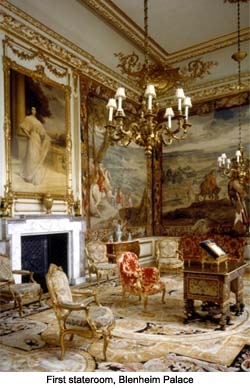 Sargent's painting isn't the most famous portrait on display in
the Red Drawing room; that honour falls to a depiction of the 4th
Duke with his family by Joshua Reynolds, circa 1778. The Duke is
dressed in Garter robes and holds a gem from the famous
Marlborough Gem collection. His son, the future Duke, is shown
clasping one of the ten ornate boxes in which the gems were
stored. Gathered by the 4th Duke in the mid to late 18th century,
the Marlborough Gems are the most important collection of cameos
and intaglios in Britain. Sadly, this is all you can see of the
gems at Blenheim since, in 1875, the 7th Duke sold the entire
collection at Christie's for the sum of £10,000.
Sargent's painting isn't the most famous portrait on display in
the Red Drawing room; that honour falls to a depiction of the 4th
Duke with his family by Joshua Reynolds, circa 1778. The Duke is
dressed in Garter robes and holds a gem from the famous
Marlborough Gem collection. His son, the future Duke, is shown
clasping one of the ten ornate boxes in which the gems were
stored. Gathered by the 4th Duke in the mid to late 18th century,
the Marlborough Gems are the most important collection of cameos
and intaglios in Britain. Sadly, this is all you can see of the
gems at Blenheim since, in 1875, the 7th Duke sold the entire
collection at Christie's for the sum of £10,000.
Winston Churchill, grandson of the 8th Duke, was born in on
30th November in a small room that lies just west of the great
hall. His parents had planned for their son to be born at their
London home on Charles Street but he was to arrive two months
prematurely while the couple were staying at Blenheim. His
father, Randolph Churchill, described the unexpected nature of
Winston's birth in a letter to his Mother-in-law:
"She [Jennie] had a fall on Tuesday walking with the shooters,
and a rather imprudent and rough drive in a pony carriage brought
on the pains on Saturday night. We tried to stop them, but it was
no use. They went on all Sunday. Of course the Oxford physician
did not come. We telegraphed for the London man, Dr Hope, but he
did not arrive till this morning. The country Dr is however a
clever man, and the baby was safely born at 1.30 this morning
after about 8 hours of labour."
Another account, by Jennie's sister, told how Jennie was dancing
at a ball held in the great ballroom and having a wonderful time
before her contractions started. There was no time to find a
suitable bedroom and so Sir Winston Churchill was born in a
nearby room, which that night had been turned into a temporary
cloakroom.
When asked to corroborate the account, Sir Winston Churchill
replied: "Although present on that occasion, I have no clear
recollection of the events leading up to it."
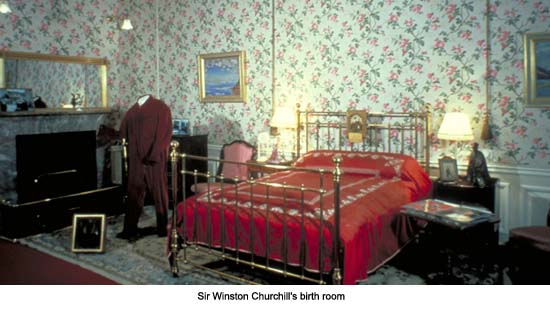
Churchill was baptised at Blenheim Chapel, located in the west
wing. The airy chapel was designed largely by Sarah, the 1st
Duchess, to honour her husband and houses an ornate memorial to
Blenheim's 1st Duke and Duchess and their sons, by William
Kent.
Despite not becoming heir to the estate, Sir Winston Churchill
had his roots in Blenheim Palace. He had an enduring love for the
house he regarded as a chapter of history set in stone. Churchill
also chose Blenheim Palace as his final resting place and is
buried beside his father, Lord Randolph Churchill, in the nearby
churchyard of Blaydon. His wife Clementine, who died in 1977, is
buried next to him.
Churchill's birth room leads on to a small Churchill exhibit. On
display are letters, photographs, curls cut from his five year
old head, a painting he did of The Great Hall and other
interesting memorabilia.
It was in the gardens at Blenheim, at the temple of Diana, that
Churchill proposed to Miss Clementine Hozier during the summer of
1908.
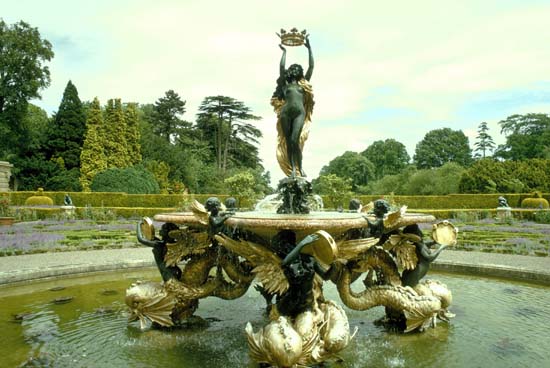
With 4,998 hectares of beautiful parkland feature gardens, lakes
to row on, the world's largest symbolic hedge maze and an
adventure playground for children, accessed by way of a mini
railway, there is so much to see in the grounds that it can be
difficult to decide in which direction to head. It's a good idea
to follow one of the walks indicated in the official
leaflets.
Originally designed by Henry Wise, the grounds were redesigned by
Lancelot 'Capability' Brown in 1764. The 1920's saw a final
redesign, when the 9th Duke of Marlborough enlisted the talent of
French landscape architect Achill Ducêne. Across from the
west wing Ducêne added the Water Terraces, styled on the
Bernini river-gods' fountain in Rome.
The first terrace features several caryatids (supporting
columns in the shape of a person) carved by Visseau. An
interesting anecdote from the time of construction tells of a
young gardener who happened to be strolling past as Visseau
carried out his work. The sculptor stopped the young man and
asked him if he'd like to be immortalised. The gardener, a local
called Bert Timms, agreed and was the model for the northernmost
caryatid.
The outdoor Terrace Café provides a wonderful excuse to
stop for refreshment and admire Ducêne's handiwork. The
Frenchman was also responsible for the exquisite Italian Garden
on the opposite side of the palace.
Those that visit the café will notice there are bottles of
Blenheim water for sale. The water comes from a source found in
the park. This wasn't the first source put to use -- in the 12th
century King Henry II had constructed a pleasure pool fed by an
ancient spring for his mistress Rosamund Clifford in The Royal
Manor of Woodstock. Now part of Blenheim Park, the square well
pool still remains and is the oldest feature in the park.
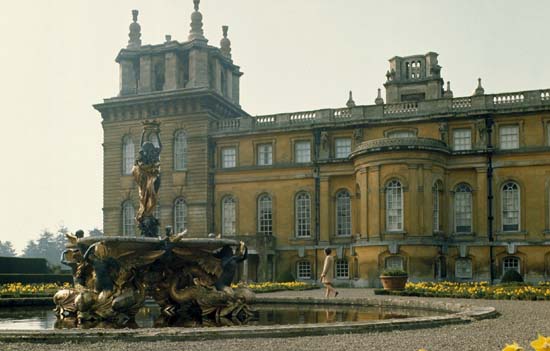
With its military connections, it's fitting that Blenehim was to
play a part during the First and Second World Wars. During the
First World War the Great Library was transformed into a hospital
for wounded servicemen. During World War II, 400 boys from
Malvern College were temporarily housed and schooled in the Great
Hall. Later, up to 1000 MI5 employees were established here
during the War, as well as members of The British Council and the
Ministry of Supply.
Arguably Britain's most magnificent stately home, Blenheim Palace
was declared a World Heritage Site by the United Nations in
1987.
More Information:
Blenheim Palace is located in the town of Woodstock, eight miles northwest of
Oxford on the A44 Evesham Road.
Related Articles:
- Chartwell: Churchill's House of Refuge, by Richard Crowhurst
- https://www.timetravel-britain.com/articles/houses/chartwell.shtml
- Christmas at Blenheim Palace
- https://www.timetravel-britain.com/articles/christmas/blenheim.shtml
More Information:
We regret that we no longer have the resources to maintain up-to-date links and/or hours and pricing details for the various sites and attractions listed on this website. For more information about the location(s) listed above, please use your favorite search engine or visit Wikipedia.
Martha Doe contributes articles to a number of publications on
travel and history.
Article © 2006 Martha Doe
Photos courtesy of Britainonview.com.
| 